Treatment of individual differences in the Physical Education class. A diagnosis from Basic General Education
Main Article Content
Abstract
The article addresses individual differences in the Ecuadorian educational reality in relation to pedagogical and didactic aspects that are somehow linked to educational processes by age and teaching systems. This paper aims to present a diagnosis of the most recent research results related to individual differences in Physical Education, in order to achieve a more inclusive teaching at the Bolivarian University of Quito. The following research methods were used: historical-logical analysis, systemic analysis, inductive-deductive analysis; and empirical methods: observation, survey, interview and triangulation. The result was aimed at making a diagnosis of individual differences, through a pre-experiment, in order to generate proposals that lead to achieving a more inclusive, integrative and sustainable education. The conclusions are the relevance of the class according to the ages, the degree of load in the effort in correspondence with health, the energy expenditure of the activities, the correction of errors, the motor and sports skills, the dosage of the loads and the characteristics of the imaginary of Physical Education today, among other important elements.
Downloads
Article Details

This work is licensed under a Creative Commons Attribution-NonCommercial 4.0 International License.
References
Abad, M. (2013). Las políticas públicas culturales del Ecuador en la época del Sumak Kawsay. Punto Cero, 18(26), 57-64. http://www.scielo.org.bo/scielo.php?pid=S1815-02762013000100007&script=sci_arttext
Arenas, D., Conti, J. V., & Mas, A. M. (2022). Estereotipos de género y tratamiento diferenciado entre chicos y chicas en la asignatura de educación física: una revisión narrativa. Retos: nuevas tendencias en educación física, deporte y recreación, (43), 342-351. https://dialnet.unirioja.es/servlet/articulo?codigo=8055266
Baños, R. F., Baena, A., del Mar Ortiz, M., Zamarripa, J., De la Fuente, A. B., & Portilla, J. L. J. (2019). Influencia de las competencias del profesorado de secundaria en los comportamientos disruptivos en el aula. Espiral. Cuadernos del Profesorado, 12(24), 3-10. https://ojs.ual.es/ojs/index.php/ESPIRAL/article/view/2141
Castillo-Retamal, F., Garrido, B., Calderón, H., Zakuda, A., Farías, T., Medel, C., & Alacaino, J. (2021). Necesidades Educativas Especiales y Educación Física: un análisis desde la propuesta curricular ministerial de Chile. Retos: Nuevas Tendencias en Educación Física, Deporte y Recreación, 42, 56-65. https://doi.org/10.47197/retos.v42i0.86977
Fierro, S., Almagro, B. J., & Sáenz, P. (2019). Necesidades psicológicas, motivación e inteligencia emocional en Educación Física. Revista Electrónica Interuniversitaria de Formación del Profesorado, 22(2). https://doi.org/10.6018/reifop.22.2.345241
Martínez Heredia, N., Santaella Rodríguez, E., & Rodríguez-García, A. M. (2021). Beneficios de la actividad física para la promoción de un envejecimiento activo en personas mayores: Revisión bibliográfica. Retos, 39, 829-834. https://dialnet.unirioja.es/servlet/articulo?codigo=7586487
Pastor, F. S., & Sánchez, Á. G. (2007). Los contenidos de las capacidades condicionales en la educación física. Revista de investigación en educación, 4, 36-60. https://revistas.uvigo.es/index.php/reined/article/view/1811
Perassi, Z., & Castagno, M. M. (2022). La evaluación y acreditación de aprendizajes universitarios en tiempos de pandemia. 2022) La Evaluación educativa que nos interpela, 1, 187-189. http://www.neu.unsl.edu.ar/wp-content/uploads/2022/05/La-evaluaci%C3%B3n-educativa.pdf#page=189
Posso, R. J., Barba, L. C., Rodríguez, Á. F., Núñez, F. X., Ávila, C. E., & Rendón, P. A. (2020). Modelo de aprendizaje microcurricular activo: Una guía de planificación áulica para Educación Física. Revista Electrónica Educare, 24(3), 294-311. http://dx.doi.org/10.15359/ree.24-3.14
Santos, R. M. (2023). Medición mediante acelerometría de los niveles de actividad física de una muestra de adolescentes españoles. Revista de Salud Pública, 21, 485-491. https://www.scielosp.org/article/rsap/2019.v21n5/485-491/es/
Schilling, C., Sánchez, A., Quintana, L., Rojas, M., Villanueva, E., Sepúlveda, A., & Castillo, F. (2023). Cambios en el currículum de la Educación Física chilena: voces desde el territorio. Ciencias de la actividad física (Talca), 24(2). http://dx.doi.org/10.29035/rcaf.24.2.1


